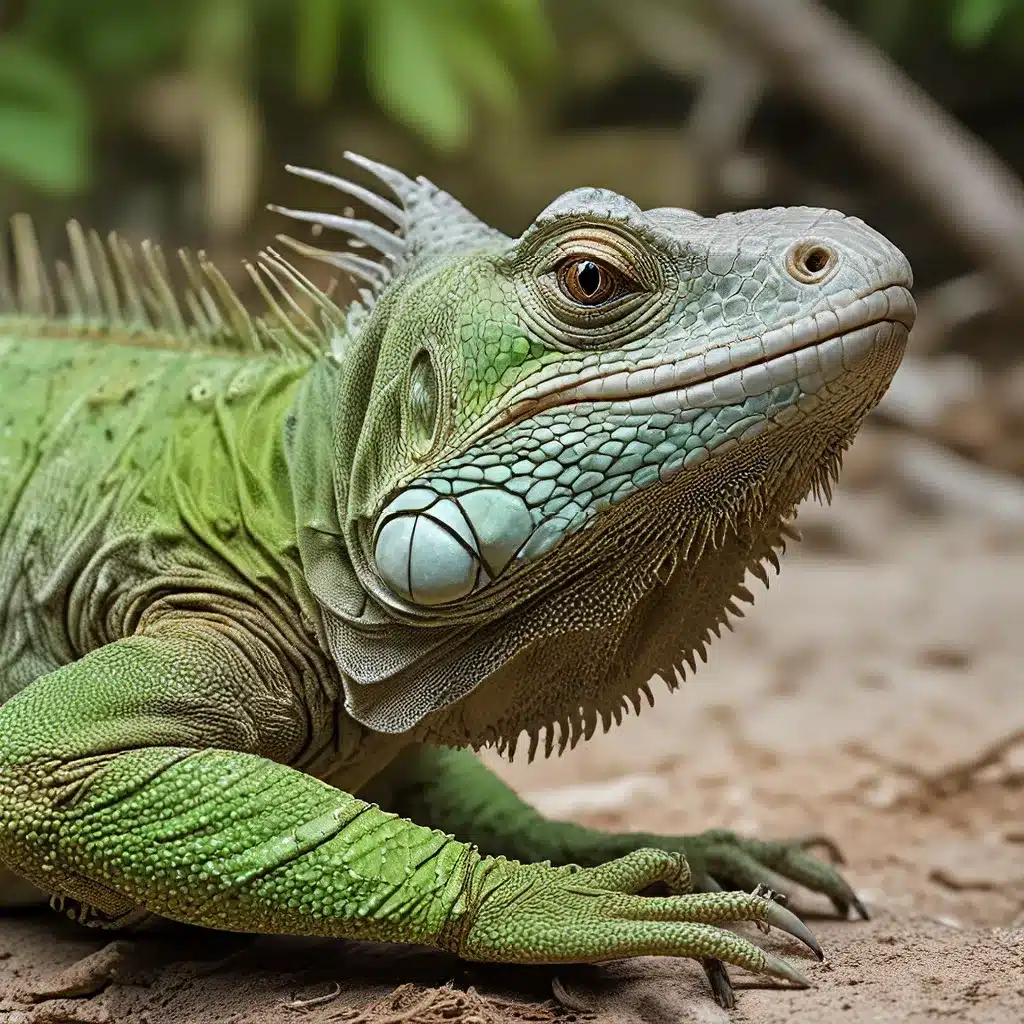
Ah, the iguana – that peculiar, prehistoric-looking creature that seems to stare right into your soul with those beady little eyes. Who would have thought that these enigmatic lizards could lead such captivating lives? Well, my friends, prepare to be amazed as we dive headfirst into the fascinating world of the inquisitive iguana.
Unearthing the Iguana’s Evolutionary Roots
Let’s start by taking a step back in time, shall we? The iguana’s lineage can be traced back millions of years, to a time when dinosaurs still roamed the Earth. These resilient reptiles have managed to adapt and evolve, surviving the great extinction that wiped out their gigantic cousins. But how, you ask? Well, it all comes down to their sheer tenacity and the incredible diversity of their species.
The Galapagos Islands, for instance, are home to a truly unique breed of iguana – the marine iguana. These remarkable creatures have adapted to their oceanic environment, learning to dive and forage for algae and seaweed in the crashing waves. Can you imagine an iguana that can swim? It’s like something straight out of a sci-fi movie!
But the iguana’s evolutionary journey doesn’t stop there. Did you know that there are over 70 different species of iguana, each with its own distinct characteristics and behaviors? From the towering Cuban iguana to the diminutive Anegada iguana, these lizards have truly mastered the art of adapting to their surroundings.
The Inquisitive Nature of Iguanas
Now, what really sets iguanas apart is their insatiable curiosity. These reptiles are the true philosophers of the animal kingdom, constantly observing and analyzing their environment. Have you ever noticed how an iguana will tilt its head, almost as if it’s pondering the meaning of life? Well, that’s because they are!
Iguanas are known to be highly inquisitive creatures, often approaching humans and other animals with a sense of cautious interest. They’ll study your every move, trying to figure out if you’re a threat or a potential source of food. And let’s not forget their impressive memory – these lizards can actually remember the faces of their caretakers and even recognize their names!
But it’s not just their cognitive abilities that make iguanas so fascinating. Their social behaviors are equally intriguing. Did you know that iguanas are actually quite territorial and will defend their space with a series of head-bobs and dewlap displays? It’s like watching a prehistoric version of a diplomatic standoff!
The Iguana’s Unique Adaptations
Now, let’s dive a little deeper into the physical adaptations that make iguanas such remarkable creatures. For starters, have you ever noticed their spiny backs and crested heads? These features aren’t just for show – they serve a vital purpose in regulating the iguana’s body temperature.
By adjusting the angle of their spines and crests, iguanas can absorb or reflect sunlight, allowing them to maintain their optimal body temperature. And let’s not forget their long, prehensile tails, which they use for balance, climbing, and even as a defense mechanism against predators.
But perhaps the most astonishing adaptation of the iguana is its regenerative abilities. These lizards can actually regrow their tails if they’re ever lost or injured. Imagine if we humans could do that – we’d never have to worry about paper cuts again!
The Galapagos Islands are a prime example of iguanas’ remarkable adaptability. The marine iguanas that call these islands home have evolved to be able to dive and forage in the ocean, a truly astonishing feat for a reptile. These iguanas have even developed the ability to change color to blend in with their surroundings, making them masters of camouflage.
The Iguana’s Precarious Existence
But as fascinating as iguanas are, their existence is often precarious. Many species of iguana are threatened or endangered due to a variety of factors, including habitat loss, hunting, and climate change.
Take the Cuban iguana, for instance. This majestic creature was once a common sight in the Caribbean, but its population has dwindled dramatically due to illegal poaching and deforestation. Conservationists are working tirelessly to protect these iguanas and restore their natural habitats, but the battle is an uphill one.
And then there’s the Anegada iguana, a tiny lizard that calls the British Virgin Islands home. This little guy is critically endangered, with only a few hundred individuals left in the wild. The Anegada iguana’s plight is a stark reminder of the fragility of our planet’s ecosystems and the importance of conservation efforts.
The Future of Iguanas
So, what does the future hold for these remarkable creatures? Well, it’s a mixed bag, to be honest. On the one hand, the increasing awareness of iguanas’ importance in their ecosystems and the growing efforts to protect them are cause for optimism. Initiatives like Golden Exotic Pets are working to educate the public about the wonders of iguanas and the crucial role they play in maintaining the delicate balance of our natural world.
But on the other hand, the ever-looming threats of habitat destruction, climate change, and illegal poaching continue to loom large. It’s going to take a concerted effort on the part of governments, conservation organizations, and everyday citizens to ensure that iguanas can continue to thrive for generations to come.
One thing is for certain, though – the iguana’s story is far from over. These resilient, inquisitive creatures have been around for millions of years, and with a little help, they’ll be around for many more. So, the next time you see an iguana, take a moment to appreciate its unique history and the vital role it plays in our world. Who knows, you might just end up as fascinated by these prehistoric wonders as I am!

